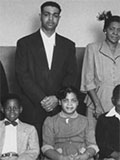

- Brown v. Board of Education full program
- President George W. Bush remarks at Brown v. Board Education Site dedication
- Justice Scalia's originalist perspective on Plessy and Brown
- President Obama on Education and Civil Rights
- Justice Alito on Plessy and Brown
- Attorney General Eric Holder on the 60th Anniversary of Brown v. Board
- School Integration: Nine from Little Rock
- Briggs v. Elliot
- Panel on the Legacy of Brown v. Board
- Thurgood Marshall and the NAACP
- Earl Warren's Judicial Philosophy
- Chief Justice Warren's Judicial Diplomacy
- Ending Separate but Equal in the Courts
- Marshall & School Desegregation Plaintiffs
- Plessy v. Ferguson
- Black vs. White School Facilities
- Doll Test
- Monroe Elementary School in Topeka
Brown v. Board of Education (1954) struck down the doctrine of “separate but equal” established by the earlier Supreme Court case, Plessy v. Ferguson. In Brown, the Court ruled racial segregation in public schools inherently unequal and unconstitutional based on the Equal Protection Clause of the Fourteenth Amendment.
Even though Linda Brown lived just blocks away from an all-white elementary school, she had to walk across railroad tracks and catch a bus to an all-black school farther away. In 1951, her father, Oliver Brown, joined with other black parents in Topeka and the National Association for the Advancement of Colored People (NAACP) to sue the local board of education, challenging school segregation. NAACP lawyer Thurgood Marshall, who went on to become the Supreme Court’s first African American justice, argued that segregated schools could never be equal. The Supreme Court, in its unanimous opinion, agreed. The justices were influenced by the famous “doll experiments,” which demonstrated the psychological impacts of internalized racism on black children. The Court ruled that segregation itself was harmful and a violation of the constitutional right to equal protection under the law. The decision prompted a backlash across the South but also contributed to a watershed moment in the civil rights movement that struck down segregation laws during the 1960s.

Oliver Brown was a welder and assistant pastor whose daughter Linda was in the third grade when he joined in a lawsuit aimed at integrating her school district. Brown’s name is associated with this famous case simply because it was alphabetically first in the list of plaintiffs. After Brown, Linda attended integrated schools through college and has continued to speak out against segregation.

Thurgood Marshall (July 2, 1908 – January 24, 1993) was chief counsel for the NAACP, representing Brown and his fellow plaintiffs before the Court. He argued 32 cases before the Supreme Court, winning twenty-nine and earning the nickname “Mr. Civil Rights.” In 1967, Marshall became the first African American Supreme Court justice (1967 – 1991).

Earl Warren (March 19, 1891 – July 9, 1974) was a California lawyer, prosecutor and governor who became chief justice of the Supreme Court (1953 – 1969). He led the “Warren Court” in enacting a series of decisions, including Brown, that transformed parts of American law.


